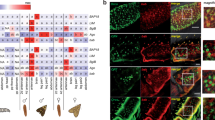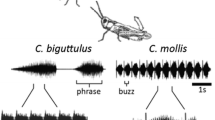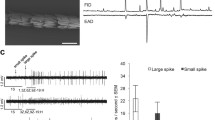Abstract
Coordinated sexual communication systems, seen in many species of moths, are hypothesized to be under strong stabilizing natural selection. Stabilized communication systems should be resistant to change, but there are examples of species/populations that show great diversification. A possible solution is that it is directional sexual selection on variation in male response that drives evolution. We tested a component of this model by asking whether ‘rare’ males (ca. 5 % of all males in a population) of the European corn borer moth (ECB), Ostrinia nubilalis, that respond to the sex pheromones of both ECB and a different Ostrinia species (O. furnacalis, the Asian corn borer, ACB), might play an important role in diversification. We specifically tested, via artificial selection, whether this broad male response has an evolvable genetic component. We increased the frequency of broad male response from 5 to 70 % in 19 generations, showing that broad-responding males could be important for the evolution of novel communication systems in ECB. We did not find a broader range of mating acceptance of broad males by females of the base population, however, suggesting that broad response would be unlikely to increase in frequency without the involvement of other factors. However, we found that ECB selection-line females accepted a broader range of courting males, including those of ACB, than did females of the base population. Thus, a genetic correlation exists between broad, long-range response to female sex pheromone and the breadth of female acceptance of males at close range. These results are discussed in the context of evolution of novel communication systems in Ostrinia.


Similar content being viewed by others
References
Allison, J. D. and Cardé, R. T. 2007. Bidirectional selection for novel pheromone blend ratios in the almond moth, Cadra cautella. J. Chem. Ecol. 33:2293–2307.
Allison, J. D. and Cardé, R. T. 2008. Male pheromone blend preference function measured in choice and no-choice wind tunnel trials with almond moths. Cadra cautella. Animal Behaviour. 76:259–266.
Allison, J. D., Roff, D. A., and Cardé, R. T. 2008. Genetic independence of female signal form and male receiver design in the almond moth, Cadra cautella. J. Evol. Biol. 21:1666–1672.
Andersson, M. 1994. Sexual Selection. Princeton Univ. Press.
Ando, T., Saito, O., Arai, K., and Takahashi, N. 1980. (Z) and (E) 12-Tetradecenyl; acetates: Sex pheromone components of oriental corn borer (Lepidoptera: Pyralidae. Agri. Biol. Chem. 44:2643–2649.
Baker, T. C. 1989. Origin of courtship and sex pheromones of the oriental fruit moth and a discussion of the role of phytochemicals in the evolution of Lepidopteran male scents. pp 401–418, in C. H. Chou, and G. R. Walker, (eds.). Phytochemical Ecology: Alleochemicals, Mycotoxins, and insect pheromones and allomones, Monograph series No. 9, Institute of Botany, Academica Sinica, Taipei.
Baker, T. C. 2002. Mechanism for saltational shifts in pheromone communication systems. Proc. Natl. Acad. Sci. USA 99:13368–13370.
Cardé, R. T. and Haynes, K. F. 2004. Structure of the pheromone communication channel in moths, pp. 283–332, in R. T. Cardé and J. G. Millar (eds.), Advances in Insect Chemical Ecology. Cambridge University Press, Cambridge, UK.
Collins, R. D. and Cardé, R. T. 1989. Selection for altered pheromone-component ratios in the pink bollworm moth, Pectinophora gossypiella (Lepidoptera: Gelechiidae). J. Insect Behav. 2:609–621.
Cossé, A. A., Campbell, M. G., Glover, T. J., Linn Jr., C. E., Todd, J. L., Baker, T. C., and Roelofs, W. L. 1995. Pheromone behavioral response in unusual male European corn borer hybrid progeny not correlated to electrophysiological phenotypes of their pheromone-specific antennal responses. Experientia 51:809–816.
Coyne, J. A., and ORR, H. A. 2004. Speciation. Sinauer Press.
Domingue, M. J., Starmer, W. T., and Teale, S. A. 2006. Genetic control of the enantiomeric composition of ipsdienol in the pine engraver, Ips pini. J. Chem. Ecol. 32:1005–1026.
Domingue, M. J., Musto, C. J., Linn Jr., C. E., Roelofs, W. L., and Baker, T. C. 2007. Evidence of olfactory antagonistic imposition as a facilitator of evolutionary shifts in pheromone blend usage in Ostrinia app. (Lepidoptera: Crambidae). J. Insect. Physiol. 53:488–496.
Falconer, D. S. and Mackay, T. F. C. 1996. An Introduction to Quantitative Genetics. Pearson, New York.
Glover, T. J., X-H, T. A. N. G., and Roelofs, W. L. 1987. Sex pheromone blend discrimination by male moths from E and Z strains of European corn borer. J. Chem. Ecol. 13:143–151.
Glover, T. J., Campbell, M. G., Linn Jr., C. E., and Roelofs, W. L. 1991. Unique sex chromosome mediated behavioral response specificity of hybrid male European corn borer moths. Experientia 47:980–984.
Haynes, K. F. 1997. Genetics of pheromone communication in the cabbage looper moth, Trichoplusia ni, pp. 525–534, in R. T. Cardé and A. K. Minks (eds.), Insect Pheromone Research: New Directions. Chapman and Hall, New York.
Haynes, K. F. and Hunt 1990. A mutation in the pheromonal communication system of the cabbage looper moth, Trichoplusia ni. J. Chem. Ecol. 16:1249–1257.
Haynes, K. F., Gaston, L. K., Mistrot-Pope, M., and Baker, T. C. 1984. Potential for evolution of resistance to pheromones: Interindividual and interpopulation variation in chemical communication system of pink bollworm moth. J. Chem. Ecol. 10:1551–1565.
Hemmann, D. J., Allison, J. D., and Haynes, K. F. 2008. Trade-off between sensitivity and specificity in the cabbage looper moth response to sex pheromone. J. Chem. Ecol. 34:1476–1486.
Hill, W. G. and Caballero, A. 1992. Artificial selection experiments. Annu. Rev. Ecol. Syst. 23:287–310.
Hillier, N. K. and Vickers, N. J. 2004. The role of Heliothine hairpencil compounds in female Heliothis virescens (Lepidoptera: Noctuidae) behavior and mate acceptance. Chem. Senses 29:499–511.
Ishikawa, Y., Takanashi, T., C-G, K. I. M., Hoshizaki, S., Tatsuki, S., and Huang, Y. 1999. Ostrinia spp. In Japan: their host plants and sex pheromones. Entom. Exp. Appl. 91:237–244.
Kearsey, M. J. and Pooni, H. S. 1996. The Genetical Analysis of Quantitative Traits. Chapman and Hall, London.
Krasnoff, S. B. and Roelofs, W. L. 1990. Evolutionary trends in the male pheromone systems of arctiid moths: evidence from studies of courtship in Phragmatobia fuliginosa and Pyrrharctia isabella (Lepidoptera: Arctiidae). Zool. J. Linn. Soc. 99:319–338.
Lassance, J. M. 2010. Journey in the Ostrinia world: From pest to model in chemical ecology. J. Chem. Ecol. 36:1155–1169.
Lassance, J. M. and Löfstedt, C. 2009. Concerted evolution of male and female display traits in the European corn borer, Ostrinia nubilalis. BMC Biology 7:10.
Linn Jr., C. E. and Roelofs, W. L. 1995. Pheromone communication in the moths and its role in the speciation process, pp. 263–300, in D. H. Lambert and H. Spencer (eds.), Speciation and the Recognition Concept: Theory and Application. Johns Hopkins University Press, Baltimore.
Linn Jr., C. E., Young, M., Gendle, M. S., Glover, T. J., and Roelofs, W. L. 1997. Sex pheromone blend discrimination in two races and hybrids of the European corn borer moth, Ostrinia nubilalis. Physiol. Entomol 22:212–223.
Linn, C. E. Jr., O'Connor M., and Roelofs, W. L. 2003. Silent genes and rare males: A fresh look at pheromone blend response specificity in the European corn borer moth, Ostrinia nubilalis. J. Insect Science. 3:15, Available online: insectscience.org/3.15
Linn Jr., C. E., Musto, C., and Roelofs, W. L. 2007. More rare males in Ostrinia: Response of Asian corn borer moths to the sex pheromone of the European corn borer. J. Chem. Ecol. 33:199–212.
Löfstedt, C. 1990. Population variation and genetic control of pheromone communication systems in moths. Ent. Exp. Appl. 54:199–218.
Löfstedt, C. 1993. Moth pheromone genetics and evolution. Phil. Trans. Roy. Soc. B 340:167–177.
Lynch, M. and Walsh, B. 1998. Genetics and Analysis of Quantitative Traits. Sinauer Associates, Sunderland MA.
Panhuis, T. M., Butlin, R., Zuk, M., and Tregenza, T. 2001. Sexual selection and speciation. Trends Ecol. Evol. 16:364–371.
Paterson, H. E. H. 1985. The recognition concept of species. pp 21–30, in E. S. Vrba, (ed.). Species and Speciation. Transvaal Museum Monograph No. 4. Pretoria.
Pélezuelo, L., Meusnier, S., Audiot, P., Bourguet, D., and Ponsard, S. 2007. Assortative mating between European corn borer pheromone races: beyond assortative meeting. PLoS ONE 2:1–10.
Phelan, P. L. 1992. Evolution of sex pheromones and the role of asymmetric tracking. pp. 265–314, in B. D. Roitberg and M. B. Isman (eds.), Insect Chemical Ecology. Chapman & Hall, New York.
Phelan, P. L. 1997. Genetic and phylogenetics in the evolution of sex pheromones, pp. 563–579, in R. T. Cardé and A. K. Minks (eds.), Insect Pheromone Research. Chapman and Hall, New York.
Phelan, P. L. 1997b. Evolution of mate-signaling in moths: phylogenetic considerations and predictions from the asymmetric tracking hypothesis. pp. 240–256, in J. C. Choe, and B. J. Crespi, (eds.). The Evolution of Mating Systems in Insects and Arachnids. Cambridge University Press.
Phelan, P. L. and Baker, T. C. 1987. Evolution of male pheromones in moths: reproductive isolation through sexual selection. Science 235:205–207.
Roelofs, W. L., Glover, T. J., Tang, X.-H., Sreng, I., Robbins, P., Eckenrode, C. J., Lofstedt, C., Hansson, B. S., and Bengtsson, B. O. 1987. Sex pheromone production and perception in European corn borer moths requires both autosomal and sex-linked genes. Proc. Natl. Acad. Sci. USA 84:7585–7589.
Roelofs, W. L., Liu, W., Hao, G., Jaio, H., Rooney, A. P., and Linn Jr., C. E. 2002. Evolution of moth sex pheromones via ancestral genes. Proc. Natl. Acad. Sci. USA 99:13621–13626.
Roelofs, W. L. and Rooney, A. P. 2003. Molecular genetics and evolution of pheromone biosynthesis in Lepidoptera. Proc. Natl. Acad. Sci. USA 100:9179–9184.
Sakai, R., Fukuzawa, M., Nakano, R., Tatsuki, S., and Ishikawa, Y. 2009. Alternative suppression of transcription from two desaturase genes is the key for species-specific sex pheromone biosynthesis in two Ostrinia moths. Ins. Biochem. Molec. Biol. 39:62–67.
Smadja, C. and Butlin, R. K. 2009. On the scent of speciation: the chemosensory system and its role in premating isolation. Heredity 102:77–97.
Sreng, I., Glover, T., and Roelofs, W. 1989. Canalization of the redbanded leafroller moth sex pheromone blend. Arch. Insect Biochem. Physiol. 10:73–82.
Symonds, M. R. E. and Elgar, M. A. 2008. The evolution of pheromone diversity. Trends Ecol. Evol. 23:220–228.
Xue, B., Rooney, A. P., Kajikawa, M., Okada, N., and Roelofs, W. L. 2007. Novel sex pheromone desaturases in the genomes of corn borers generated through gene duplication and retroposon fusion. Proc. Natl. Acad. Sci. USA 104:4467–4472.
Acknowledgments
We thank Kathy Poole and Paula Fox for help in maintaining the moth colonies and selection lines. We also thank Tom Glover for discussion on the selection protocol. The research was supported by a grant to W.L.R and C.E.L from the National Science Foundation #0343409.
Author information
Authors and Affiliations
Corresponding author
Rights and permissions
About this article
Cite this article
Droney, D.C., Musto, C.J., Mancuso, K. et al. The Response to Selection for Broad Male Response to Female Sex Pheromone and its Implications for Divergence in Close-Range Mating Behavior in the European Corn Borer Moth, Ostrinia nubilalis . J Chem Ecol 38, 1504–1512 (2012). https://doi.org/10.1007/s10886-012-0208-5
Received:
Revised:
Accepted:
Published:
Issue Date:
DOI: https://doi.org/10.1007/s10886-012-0208-5




